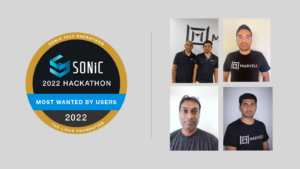Welcome to our blog series where we catch up with the winners of the SONiC Hackathon 2022. In this blog series, we’ll dive into their innovative projects, their journey after the SONiC Hackathon, and how their projects are making a difference in the open networking world. Today, we sat down with the team from Marvell, who worked on optimizing SONiC and reducing SONiC bare metal costs, the recipient of the “Most Wanted By Users” award.
Can you briefly introduce yourself and your team? How did you all come together for the 2022 SONiC Hackathon?
Hello, I’m Ravindranath Kanakarajan, and I’ve been actively engaged with the SONiC and SAI communities for several years. My colleague Antony Rheneus has a longstanding involvement with SONiC, notably contributing ARM support to the project. Satheesh Kara and Maulik Patel specialize in Marvell SAI, playing a pivotal role in facilitating numerous SONiC releases on Teralynx. Jithender Reddy Kondam has been dedicated to supporting SONiC customers as part of the Marvell team.
Our team is a diverse blend of SAI and SONiC developers, as well as SAI and SONiC customer solutions engineers. Geographically, we span across India and the United States. We often discuss problems faced by our SONiC customers and things we can improve. This hackathon idea was an offshoot of one such discussion.
What inspired your project for the 2022 SONiC Hackathon? Could you describe what your project was for those who may not be familiar with it?
Our project for the 2022 SONiC Hackathon was built on our contribution of ARM platform support to SONiC, which expanded SONiC’s deployment possibilities, including its use as management switches. One of the key challenges we identified was the need to lower the bare metal Bill of Materials (BOM) costs associated with deploying SONiC.
To address this challenge, our project focused on reducing the size of the SONiC image footprint. Specifically, on ARM platforms, the SONiC image footprint occupied a substantial 1GB of storage space. Our goal was to significantly shrink this footprint. By doing so, we aimed to achieve multiple benefits:
- Performance Improvement: A smaller image footprint typically results in faster boot times and overall improved system performance.
- Cost Reduction: Reducing the size of the SONiC image can help lower the flash memory costs associated with hardware boards, making SONiC more cost-effective for deployment.
In essence, our project aimed to optimize SONiC for ARM platforms, making it more efficient, cost-effective, and accessible for a broader range of deployment scenarios.
How did winning the award in your respective category (Most Wanted By Users, Most Impactful, Most Innovative) impact you and your team?
Winning the “Most Wanted By Users” award had a significant impact on both our team and our involvement in the SONiC community. It has served as a source of motivation for our team. It encouraged us to continue our contributions to SONiC and to explore even more innovative solutions to networking challenges.
After winning the award, we received requests for collaboration on various SONiC-related projects. This expanded our network of collaborators and hopefully will lead to fruitful partnerships.
Since the Hackathon, what progress has been made on your project? Could you share any significant milestones or achievements?
We have dedicated substantial effort to stabilize the reduced SONiC image, triaging and resolving bugs, performance bottlenecks, and compatibility issues that have emerged as a result of the image size reduction.
What are your current projects? Are they an extension of your hackathon project or something entirely new?
Our current projects encompass a mix of ongoing feature contributions to SONiC, as well as active involvement in the newly formed SONiC Debian Working Group, which is being chaired by Marvell.
In terms of feature contributions to SONiC, several of our projects have already been successfully merged into the SONiC 202305 release. These enhancements and features are aimed at improving the functionality and performance of SONiC.
Additionally, we have several other projects in progress, with the goal of having them incorporated into the upcoming SONiC 202311 release. These projects represent our continued commitment to enhancing and evolving SONiC to meet the evolving needs of its user community.
Could you share your future plans? How do you see your project evolving in the next few years?
We are working towards stabilizing our slimmed down SONiC image. Apart from this, SONiC’s support for various hardware architectures, including ARM and x86, will remain a focus. We aim to further optimize and tailor SONiC for these platforms, ensuring efficient utilization of resources and maximizing performance.
What advice do you have for future participants in the SONiC Hackathon? What do you wish you had known before participating?
Based on us winning the “Most Users Wanted”, it is good to have a diverse team that understands the customer’s pain points. Having a clear and meaningful problem statement goes a long way not just for winning the hackathon but also gaining more deployments for SONiC.
While the hackathon is a competition, it’s also an opportunity to learn, collaborate, and network with like-minded individuals passionate about open-source networking. So do not forget to network, forge partnerships and enjoy the experience.
